Portugal is easily one of the most rewarding travel destinations in Europe, with cosmopolitan cities, quaint villages, wine country, pristine forests – and not to forget, 1,800 kilometres (1,100 miles) of picturesque coastline ranging from dramatic cliffs, coves and caves to placid, sandy beaches.
Add to that more than 800 years of history, a fabulous food scene, music traditions and much more, and mainland Portugal plus the diverse islands of Madeira and the Azores have something to offer literally every type of traveller.
This mega Portugal Bucket List brings together 28 of the best things to do in Portugal, including must-sees, immersive cultural experiences, hands-on activities, and quirky and alternative Portugal attractions.
→ Don’t miss: The best places to visit in Portugal
Please note: This post contains affiliate links, meaning I may earn a commission if you make a purchase by clicking a link (at no extra cost to you). Learn more.
28 of the best things to do in Portugal
Ride the #28 tram in Lisbon
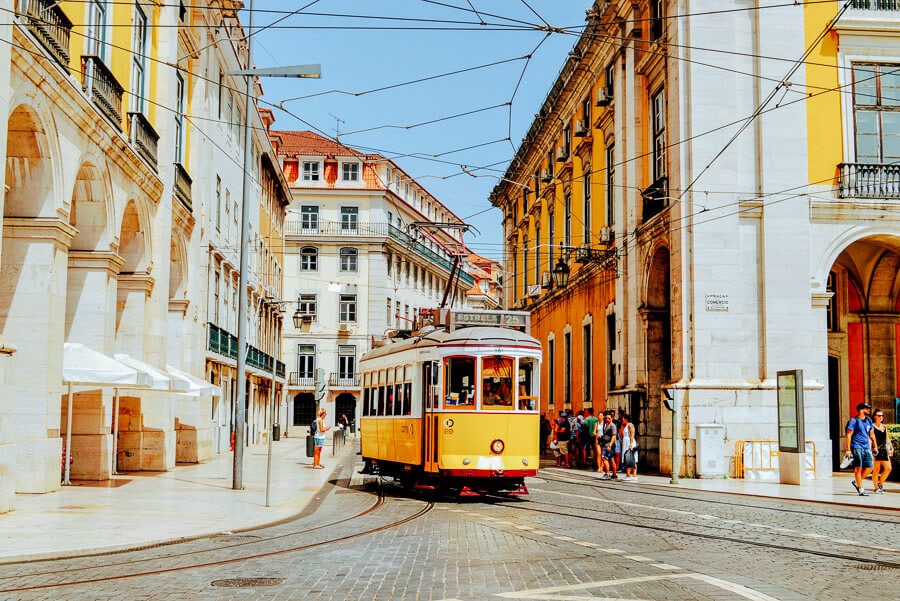
There’s no better introduction to Lisbon, the capital city of Portugal, than a self-guided tour by tram. A Lisbon icon, electric trams first launched in 1901 and have been ferrying locals and visitors alike up and down the city’s hills ever since.
Tram 28 is the best route for sightseeing and views. Think of it as Lisbon’s more authentic answer to a hop-on-hop-off tour bus! Running between Martim Moniz and Campo Ourique, it takes passengers along some of the city’s most beautiful streets, past key landmarks including Lisbon Cathedral, the Thieves Market, São Jorge Castle, National Pantheon, Miradouro da Graça, Arco da Rua Augusta, and more.
At just €3 per trip (paid either in cash to the driver or using a rechargeable Viva Viagem card), it’s also a very affordable way to see the best of Lisbon. Climb aboard a vintage Remodelado carriage, stake out a spot on one of the wooden benches, and sit back and absorb the sights and sounds of Lisboa.
The tram runs seven days from 6am. It’s a good idea to arrive early to beat the crowds. Riding the whole line takes around 50 minutes one-way depending on traffic. For a less-touristy alternative, the #12E tram follows a similar route through the historic Alfama neighbourhood, stopping at São Jorge Castle and Se Cathedral.
Alternative Lisbon experience: Follow the 28 tram route in a private electric tuk-tuk and snap photos of the charming yellow trams along the way!
Learn how to make Pastel de Nata in Belem

When visiting Portugal, it’s mandatory to munch on as many rich and flaky Pastel de Nata (Portuguese egg tarts) as humanly possible. This delicious pastry was born in the shadow of the iconic Belem Tower (Torre De Belem) in the 18th-century kitchens of Jerónimos Monastery, making Lisbon the spiritual home of Pastéis.
While you should definitely buy a pack or two of authentic Belem custard tarts to take home as a souvenir, why not go one better and learn how to make them from scratch yourself. It’s a life skill that will serve you well!
A Pastel de Nata Masterclass is a must-do for foodies and a great experience for kids. The original recipe is a closely guarded secret, but padeiras are more than willing to spill the beans for eager visitors who want to master the art. The best workshops take place in local bakeries and teach you how to make the creamy custard from scratch.
Try it: Book a Pastel de Nata Workshop with an expert baker, including a glass of Ginjinha sour cherry liqueur in an edible chocolate cup to pair with your fresh-baked tarts.
Cruise the Douro River in Porto
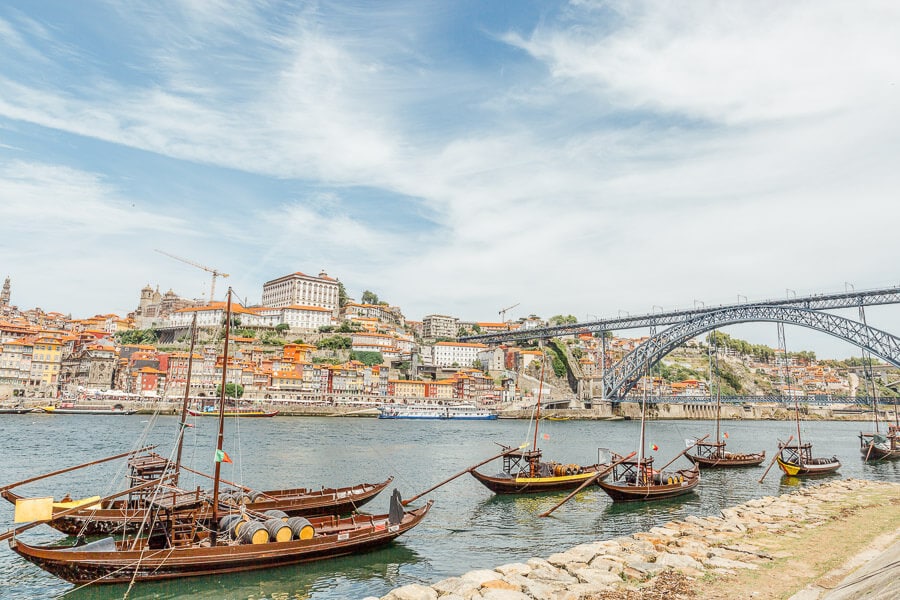
Life in Portugal’s second city revolves around the Douro River, giving Porto some of its most famous landmarks including its handsome bridges and medieval Ribeira (riverside) district, with its colourful merchant houses and historic cafes.
Do as Porto’s wine merchants once did and let the trade winds whisk you through the city. A boat trip on the Douro is the perfect way to tour the top sights and learn what makes Porto one of the country’s most interesting cities.
In the past, rabelo – low-slung wooden cargo boats – were used to transport barrels of Port wine from the vineyards in the country’s interior to the city and onward to the shipping docks. A fleet of colourful rabelo now float the same historic route, taking visitors down Porto’s life-giving river and showing off the best of the city from a unique perspective.
A typical boat tour of Porto covers the famous ‘Six Bridges’ including Ponte D. Maria Pia, Ponte Infante Dom Henrique and Ponte de Dom Luís I, the Gaia caves, and the Cabedelo Nature Reserve. You’ll see the Foz do Douro, where the river empties out into the Atlantic Ocean, and the Barra do Douro with its dazzling lighthouse.
Take a day trip to the splendid Pena Palace
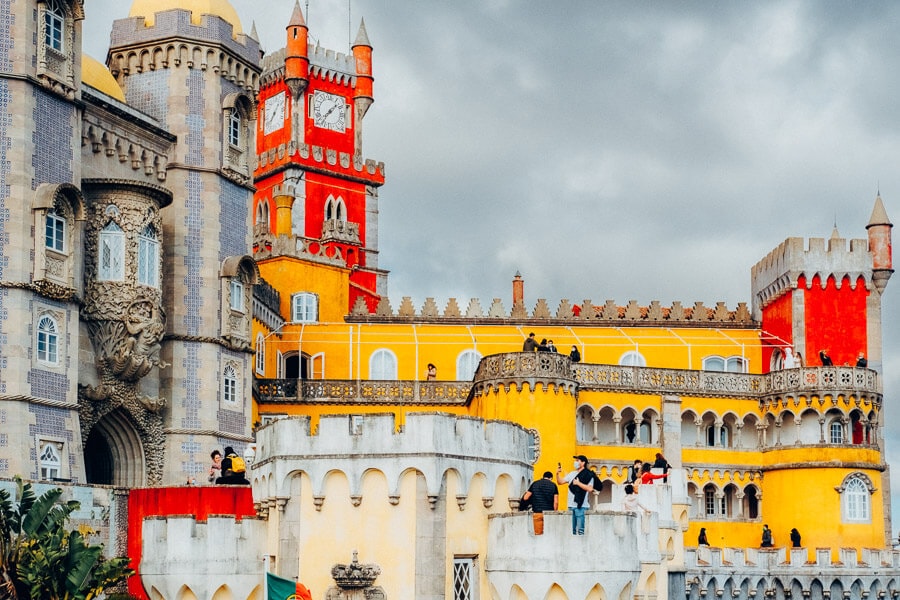
Pena Palace (Palácio da Pena) is one of the most popular tourist attractions in Portugal and a highlight of Sintra, a convenient day trip from Lisbon. Considered one of the finest expressions of 19th-century Romanticism in Europe, it’s both a UNESCO World Heritage Site and one of the Seven Wonders of Portugal.
Set atop a hill and enveloped by green forest (200 hectares of which is the royal garden), Pena Palace is instantly identifiable because of its bright red, yellow and mauve facades, scalloped white trimmings and pointed turrets. It might look cartoonish in photos but seen up close in person, it’s very lavish indeed – especially the painted interiors, which were used as a summer royal residence for Portugal’s ruling family.
A Sintra day trip is very easy to organise, travelling by train on the CP-Sintra line from Lisbon. Pena Palace is a 30-minute bus ride from the railway station.
Alternatively, a combination Sintra, Cabo da Roca and Cascais day tour from Lisbon is a good choice if you’re on a tight timeline. Other noteworthy landmarks in the area include the National Palace on Sintra’s central square, Monserrate Palace and the Moorish Castle, later on this list of things to do in Portugal.
Pena Palace tickets: Pre-purchase your tickets online and skip the queue.
Listen to Fado music in Chiado, one of the best things to do in Portugal for local culture
Recognised as part of UNESCO’s Intangible Cultural Heritage of Humanity, Fado is a beloved Portuguese tradition that incorporates music, lyrics and movement. For an insight into the nation’s seafaring heritage, watch a live Fado performance in Chiado in Lisbon where Fado has been humming in the streets for more than 200 years.
Though its exact origins are a bit of a mystery, it’s widely believed that Fado emerged in the mid-1800s at a time when Portuguese mariners were undertaking their most daring sea voyages to the New World. Singing and dancing became something of a ritual for sailors as they searched for a reprieve from their stressful day jobs.
Somewhat ironically, much of Lisbon’s Fado music is soulful and almost mournful. Coimbra Fado, by contrast, is more upbeat – apparently it was devised as a way for male students at the university to woo their female counterparts!
Fado is most commonly associated with Lisbon’s old Alfama and Mouraria districts. In the beginning the singers were all male, but today it’s women who take the lead, reciting stirring melodies that transport listeners to another time and place, accompanied by 12-string guitars and violas. Bars and restaurants in Alfama and Bairro Alto host Fado performers, and the popular Fado in Chiado theatre stages shows every night of the week.
Experience Fado: Folk music performances in Lisbon.
Tour one of the world’s oldest universities in Coimbra

Have you ever been to a university that is a combination of a palace, a church and has strong vibes of Harry Potter’s Hogwarts? If you haven’t, it’s time to add Coimbra University to the long list of things you must do in Portugal.
Coimbra is the biggest city in Central Portugal. You can easily reach it by train from Lisbon in about two hours or Porto in about one hour, or stop here on your road trip from Lisbon to Porto. There are many historical monuments in Coimbra but the university campus, designated as a UNESCO World Heritage Site in 2013, is the most famous.
With a history dating back to the 13th century, this stunning university is actually the oldest of its kind in Portugal and one of the oldest in Europe. It is located in what used to be a royal palace and has many interesting treasures to explore as well as commanding fabulous views of Coimbra and the Mondego River.
Some of the most interesting places on the university campus are the Capela de São Miguel, with its beautifully decorated ceiling and walls, the chambers of the palace, and the rooftop balcony that offers excellent views of the area. One place you must visit is the Biblioteca Joanina. Walking into this ancient library feels like stepping into a movie set: all golden decorations, a piano, and a resident colony of bats!
You can visit Coimbra University by yourself if you wish, but it’s best to take a tour to learn about the history and secrets that hide in the various chambers. The university organises guided tours. Note that if you buy your own tickets, there are two types – make sure you buy the one that includes a visit to the library.
By Maya from Chasing Lenscapes
Pre-purchase your Coimbra University tickets: These skip-the-line tickets include an in-depth 90-minute tour of the main halls and the Biblioteca Joanina.
Take a stroll in the enchanting Bucaco National Forest
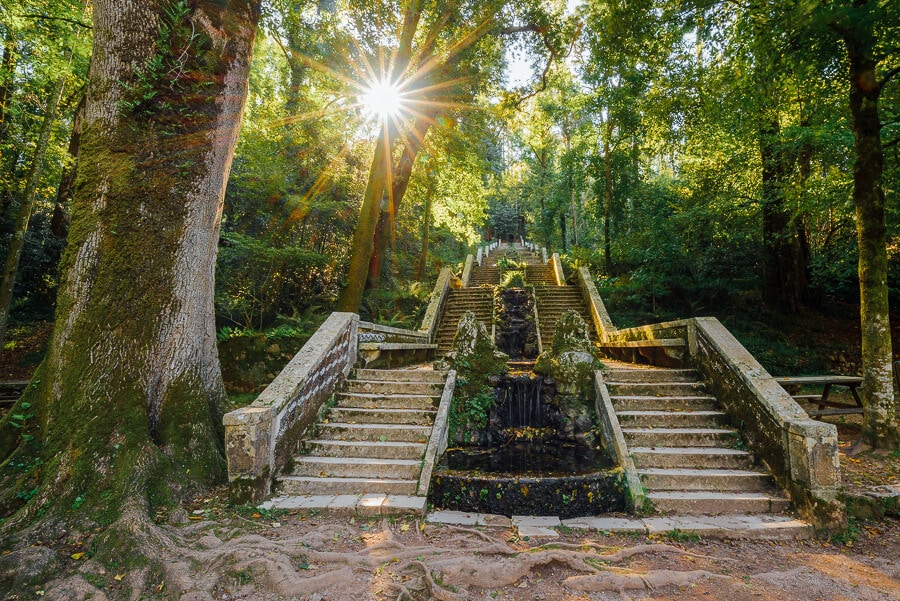
Located roughly 30 kilometres (19 miles) north of the historic city of Coimbra, the Buçaco National Forest is a true gem in Portugal. This 105-hectare green space houses one of the most remarkable tree collections in Europe, including species dating back to the Portuguese Age of Discoveries (around 500 years ago).
In the 17th century, the forest was settled by the Order of Discalced Carmelites – though it was previously inhabited for centuries before that. The monks built its walls, little chapels that are still standing today, and a convent that was supposed to be converted into a royal palace but is now a unique luxury hotel, the Buçaco Palace.
The best way to explore the forest is by foot, walking at least one of the many trails that take you through this enchanted place. Be sure to grab a map at the information centre (Posto de Turismo do Luso-Bussaco) as it will be very useful. Some of the points of interest you can’t miss while wandering through Buçaco are the Buçaco Palace, Fonte Fria fountain, and Portas de Coimbra (Coimbra Gate).
The most convenient way to get to the forest is by car, so this is a great opportunity to take a scenic road trip through central Portugal.
By Or from My Path in the World
Drink Port wine in the Douro Valley

If you’re in Portugal and you haven’t tried Port wine, have you even been to Portugal at all?! A tasting of the nation’s most famous export is an absolute must, and the best place to do it is the Douro Valley outside Porto, one of Europe’s most famous wine regions.
There are many advantages to doing a wine tasting in the Douro Valley rather than in Porto city. In Porto, you will only find overpriced touristy Port tastings; whereas in the Douro Valley, you will be able to visit centuries-old wine estates (quintas) in person. The acres and acres of vineyards here are incredibly picturesque and give visitors the chance to really immerse themselves in Portugal’s winemaking traditions.
The best way to visit the Douro Valley is through an organised tour from Porto. This one by Living Tours includes two different quintas, a boat tour on the Douro river, and a generous lunch. It’s also possible to rent a car and visit multiple quintas on your own. But that would mean you can’t drink port – so a tour is definitely the preferred option here!
By Lara from The Best Travel Gifts
Best Douro Valley tour from Porto: This itinerary by Living Tours includes tastings with the winemakers, a regional lunch, and spectacular views of the terraced vineyards.
Hike the Seven Hanging Valleys Trail in the Algarve

There are few better ways to appreciate the beauty of the Algarve coastline than by foot. And thankfully, there are several stunning walkways you can take to explore one of Portugal’s premier beach holiday destinations from a different perspective.
One of the most popular walks along this stretch of sun-kissed shoreline is the Seven Hanging Valleys Trail. At just under 12 kilometres (7.5 miles) out and back, it’s an easy half-day hike, or you can do it over a full day and enjoy the many beaches you’ll pass along the way.
Beaches aside, there’s plenty to see along the path such as natural grottos (including the famous Benagil sea cave), rock arches and bridges, sea pillars, and a lighthouse.
The family-friendly hike is described as moderate, and can be hard going in the heat of the summer months, so do yourself a favour by hiking in autumn instead. At this time of the year, you’ll enjoy sublime temperatures, fewer crowds, and won’t have to jostle for a parking spot.
You can complete the track in either direction, starting at Praia Vale de Centeanes or Praia da Marinha. If you don’t fancy retracing your steps it’s possible to just do it one way and catch a cab or Uber back to your car.
By Nadine from Le Long Weekend
Kayak through the Benagil sea cave
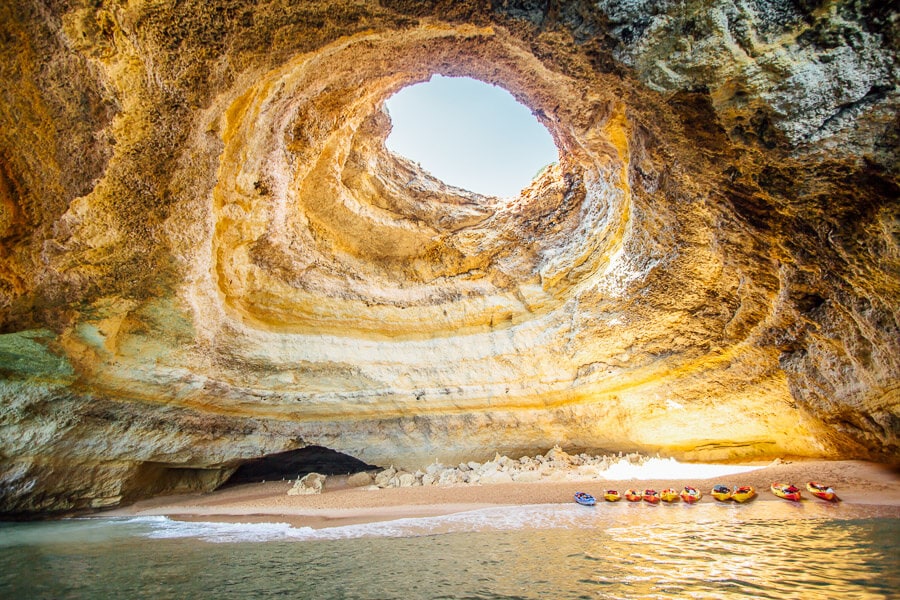
Out of all grottos that dot the southern Portuguese coast, the Benagil cave is the most captivating. That’s because, in addition to the lateral erosion caused by the pounding waves, the rain has worn away the top of the cave. The result is a natural skylight that illuminates the cavern and the beautiful patch of white sand that lies inside.
The fenced area around this ‘eye’ allows visitors to peer inside from the top of the cave. But to truly experience the magic of the Benagil grotto, you need to access it from the water.
Instead of hopping on one of the small tourist boats that pass through the cave, you could join a Benagil cave tour by kayak or SUP. Most of these tours are organised in the morning, allowing you some time to enjoy this mesmerising cave without the constant boat traffic. The beauty of arriving by kayak or SUP is that you’re allowed to actually set foot on the gorgeous beach – a privilege that boat visitors don’t have.
A kayak or SUP tour typically lasts around two hours and takes you to see several intriguing sea caves along the coastline. It can be quite intensive, depending on the water conditions, but a support boat with a lifeguard tags along and can tow your kayak if necessary.
By Sarah from CosmopoliClan
Try it: Book your Benagil cave kayaking experience with Secret Algarve.
Swim in a natural hot spring in the Azores
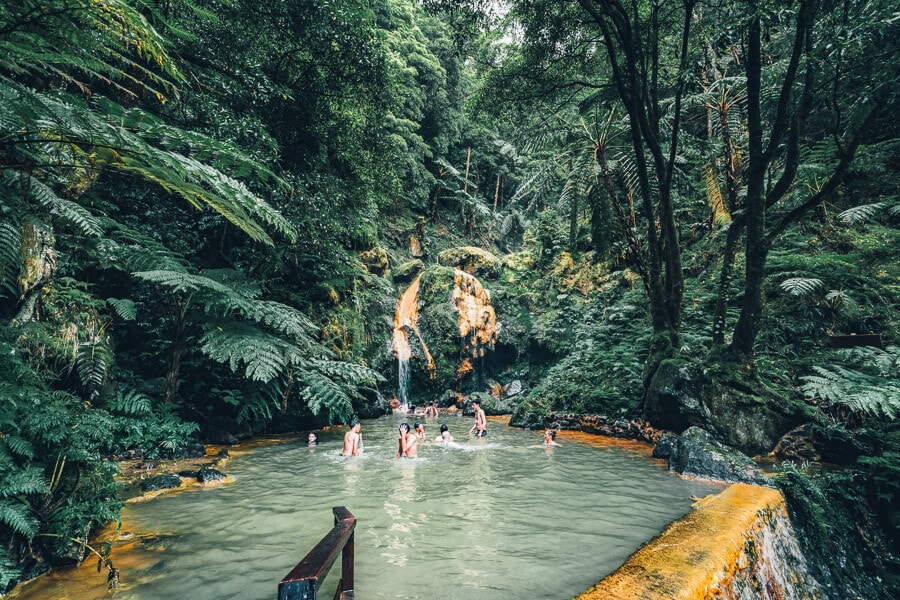
One of the most exciting things to do in Portugal is experience the hot springs on the Azorean island of São Miguel. The largest of the Azores – a chain of islands in the Atlantic Ocean and an autonomous region of Portugal – São Miguel has a wide selection of hot springs to enjoy.
There are several different geothermal springs on the island, each with its own unique feel. Terra Nostra is probably the most famous, known for its large spring-fed pool that is so rich with iron and other minerals that the water is almost golden in colour. Terra Nostra also has smaller springs as well as a botanic garden and a restaurant where you can eat cozido, an Azorean stew cooked underground using geothermal heat (look out for it later on this list).
Another cool spot is in Ponta da Ferraria, where a hot spring meets the ocean just where some rocks make a natural pool. You’ll have to time the tides just right – otherwise it can be too hot or too cold – but it’s a magical experience feeling the water’s temperature ebb and flow as the hot spring water mixes with the brisk Atlantic waters. Best of all, it’s free!
Should you want even more soaking time on your Sao Miguel itinerary, there are several other hot springs in the Azores also worth mentioning, including Poça da Dona Beija and Caldeira Velha.
Tip: Bring a dark-coloured bathing suit to enjoy the hot springs in the Azores – lighter suits may get stained by the mineral waters.
By Allison from Eternal Arrival
Experience it: Evening tour to Furnas for hot spring bathing at Poça da Dona Beija as the sun sets plus a traditional dinner under the stars.
Go hiking at sunrise on Madeira Island
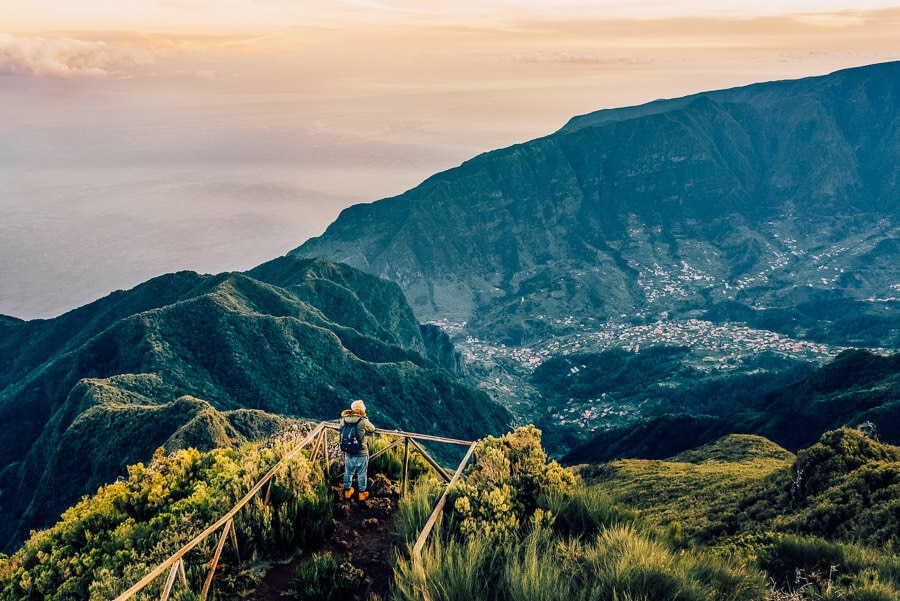
Portugal’s second autonomous island region, Madeira, comprises four islands, each with a subtropical climate and breathtaking landscapes of volcanic rock formations, dramatic cliffs and pebble beaches. It’s no secret that Madeira boasts some of the most beautiful hiking trails in Europe, many leading to high-altitude viewpoints for panoramic views of the cliffs and ocean.
From moderate and flat levada walks that take you through the island’s forested interior (a UNESCO World Heritage Site) to more challenging mountain summits that see you rise up above the clouds, Madeira is a hiker’s paradise.
The Pico Ruivo do Paul trail is an easy hike of 1.5 kilometres (just under 1 mile), taking around 45 minutes to complete. It culminates at a 1600-metre-high marked viewpoint where you are rewarded with spectacular views down to the water’s edge.
One of the most adventurous things to do in Portugal is to set out for sunrise on another popular but longer trail that links the island’s two highest points, Pico do Areeiro and Pico Ruivo. This Madeira hike is more strenuous, taking around 7-9 hours to complete the 15.6 kilometres (9.7 miles).
Ride a moliceiro boat in the quaint town of Aveiro
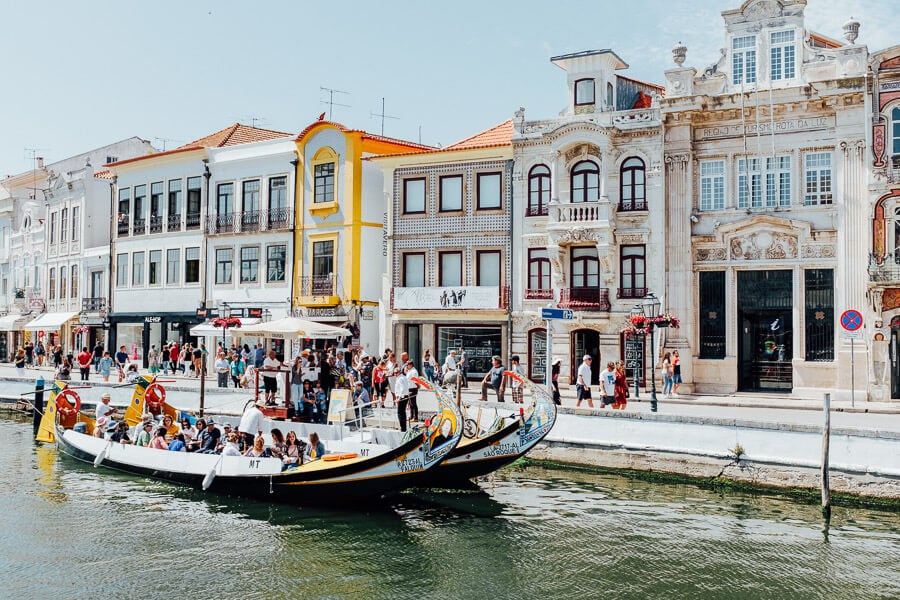
One of the best day trips from Porto is to Aveiro, a charming town known for the gondola-style boats that roam the canals. With a long history, it’s a cultural wonderland with plenty of sights and culinary experiences thrown in for good measure.
Just an hour from Porto by train, Aveiro is easy to reach and explore on foot. The main activity is riding one of the colourful molicero boats. These were originally used to farm seaweed and keep the region fertile, although they’re now more of a popular tourist attraction. A short ride will set you back €5-10.
Another place to visit is the nearby Costa Nova, a small beach town with Instagrammable huts painted in every colour of the rainbow. It’s easy to reach Costa Nova from Aveiro by hopping on a bus or hailing a taxi.
Finally, don’t miss indulging in Aveiro’s culinary gems. Ovos moles are traditional snacks from Aveiro made with sweetened egg yolk in wafer. Many cafes sell them, but there’s nowhere better than Confeitaria Peixinho where they have been made since 1856. Try the ones shaped like mini molicero boats!
By Rose from Where Goes Rose
Try it: Aveiro moliceiro experience with a visit to the Aveiro salt pan, the old Beira-Mar, neighbourhood, the Jerónimo Campos ceramics factory, and the Fish Market.
Go azulejo hunting in Porto
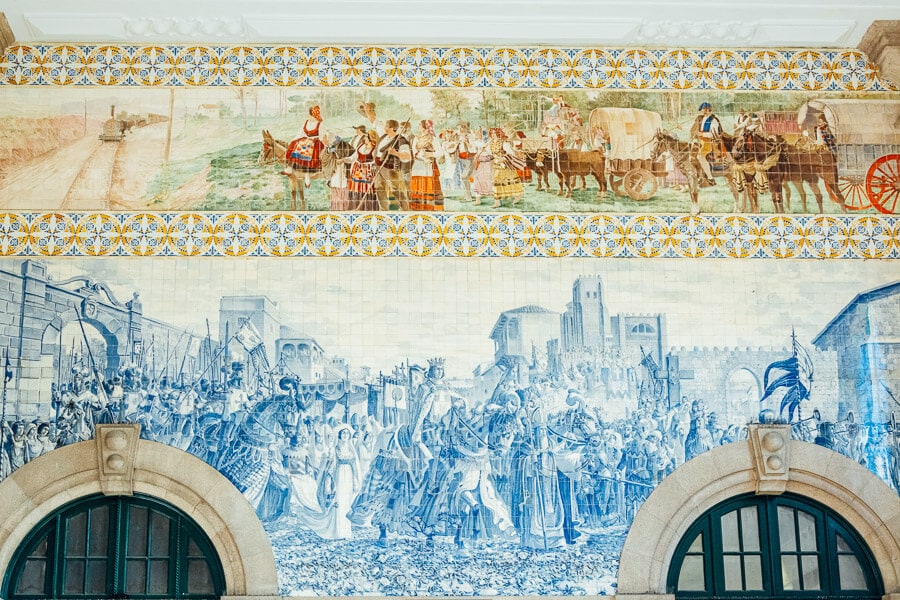
Discovering the gorgeous azulejo tiles is one of the best things to do in Porto, Portugal. The word ‘azulejo’ stems from the Arabic al zellige, which means ‘polished stone’. You will find these glazed ceramic tiles almost everywhere in Porto – from churches to railway stations, fountains to benches. Azulejo is a very important part of Portugal’s cultural heritage.
King Manuel I of Portugal brought this art form to this country in the 15th century from Seville, Spain. Initially tiles used simple geometrical patterns, but over time the repertoire transformed into a more intricate and decorative art form depicting religious stories and the history of the nation. You will mainly find these tiles in blue and white. Shades of yellow and green are also common.
You can easily explore Porto’s azulejos yourself. You will find some of the greatest works inside the Sao Bento Railway Station, where almost 20,000 azulejo tiles painted in the early 20th century by Jorge Colaco depict the history of Portugal and rural scenes. The work took almost 11 years to complete!
Other outstanding azulejos can be found at the Porto Cathedral, Igreja do Carmo, Capela das Almas, Igreja de Santo Ildefonso and the Casa da Musica.
By Moumita & Sankha from Chasing the Long Road
Alternative experience: Try a tile-painting workshop where you’ll learn about the history of azulejos while hand-painting your own souvenir tiles.
Browse the beautiful Livraria Lello bookshop in Porto

Located in the heart of Porto, the Livraria Lello is considered one of the most beautiful bookstores in the world. J.K. Rowling, author of the famous Harry Potter series, was famously inspired by it when writing her novels – she regularly visited the bookstore in the 1990s.
Founded in 1906 by the Lello brothers, the Livraria Lello, which is today one of the most famous Portuguese landmarks, attracts plenty of tourists thanks to its amazing design. Even before entering the bookstore, the white facade that combines Art Nouveau and neo-Gothic styles is quite stunning.
The exterior is certainly eye-catching, but it’s the store’s stunning interior to which the Livraria Lello owes its fame: the walls, lined with large bookcases from floor to ceiling, abound with volumes in all languages. The high point is definitely the iconic red spiral staircase.
This bookstore is so popular that an entrance fee is now charged (it costs €5, but the ticket price is deductible if you buy something inside). In any case, it’s a good idea to purchase your tickets in advance – otherwise you’ll have to queue twice: first at the ticket counter and then again to enter the bookstore. Try to visit in the morning to avoid the crowds on the staircase.
By Nesrine from Kevmrc Travel
Explore Tomar, Batalha and Alcobaca, the trio of UNESCO World Heritage Sites in Central Portugal

One of the best things to do in Portugal is visit the country’s UNESCO World Heritage Sites. There is a trio of monuments located in Central Portugal that can be visited in one day as they are all located within an hour of one another.
The three UNESCO World Heritage Sites are the Convent of Christ in Tomar, Alcobaça Monastery, and the Monastery of Batalha. The first, the Convent of Christ in Tomar was originally a 12th-century Knights Templar stronghold until its dissolution in the 14th century. The Knights of the Order of Christ, as the Templars became in the 15th-century, continued at Tomar and aided Portugal in its maritime explorations during the Age of Discoveries. The site consists of both a convent and a castle built in the Romanesque, Gothic and Renaissance styles.
The Monastery of Batalha is a Dominican monastery originating in the late 14th century. It contains examples of Gothic and Manueline architecture styles. Alcobaça Monastery is a 12th-century monastic site credited with introducing Gothic buildings to Portugal.
All three sites are rich in architecture and history. All can be visited as part of a day trip tour from Lisbon if you are travelling in Portugal without a car. There is a discounted ticket for entry to all three sites which is valid for one year.
By Cath from Passports and Adventures
Day tour option: Book a private day trip from Lisbon with transfers and skip-the-line access to the monasteries.
Walk the medieval walls of the Moorish Castle in Sintra
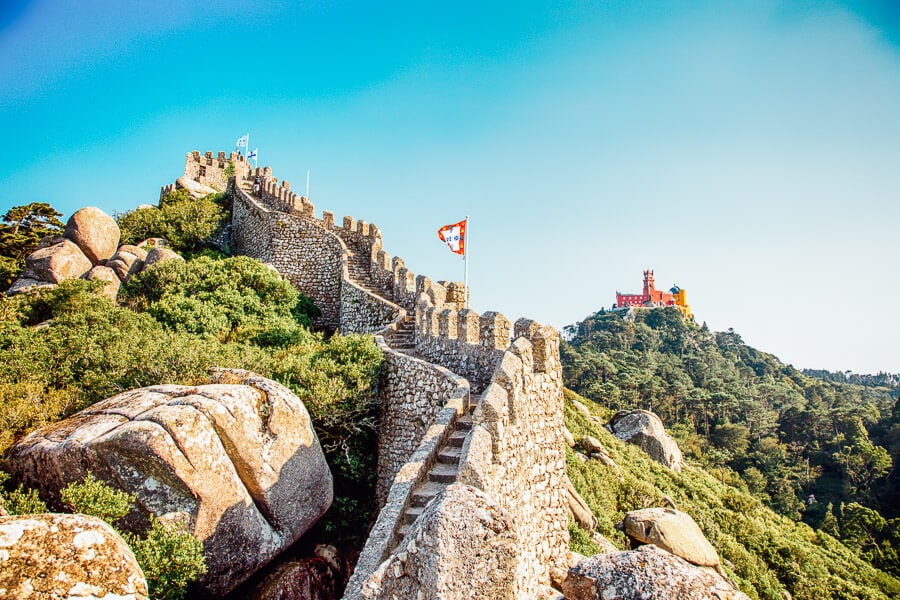
Castelo dos Mouros (the Moorish Castle) is located in Sintra. Like the Pena Palace, it sits high on a craggy outcrop and can be seen for miles around. It’s less touristy than Pena and a more relaxing experience. Its rich history and spectacular views earn the Moorish Castle a spot on the best Sintra tours from Lisbon.
The Moors reigned from the 8th to the 12th centuries in Portugal and during this time, the strategic location of this very large castle (directly above the town) meant that it was the defensive centre for the whole Sintra region. This was also true during the later Christian rule of Sintra.
Make sure you stroll around the formidable castle walls and see the 12th century Igreja de São Pedro Chapel. From atop the walls there are incredible views of the Sintra mountain range.
This castle is also an unforgettable sight when you see it from a distance. The Royal Tower of Sinta (Torre Real) is the best place to view the castle from afar. Walking from the Pena Palace to the Moorish Castle is a wonderful experience, but there is also a regular bus service.
By Paula from Portugal Travel Hub
Explore the old town in Obidos
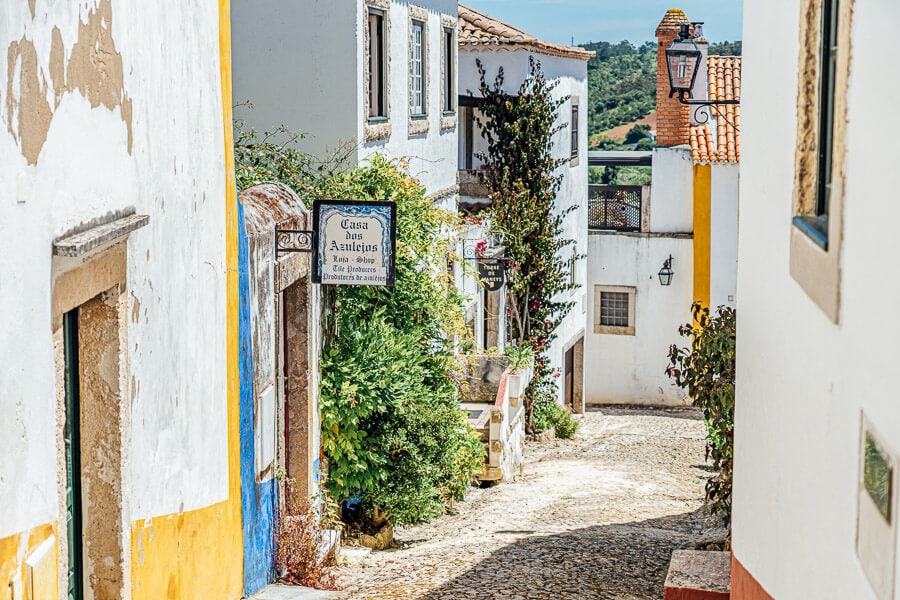
Only an hour’s drive away from bustling Lisbon (making it a great spot on a Portugal road trip), the sweet, fairytale village of Obidos is a must-see in Portugal. The town is still surrounded by fortified walls and was actually gifted from King Denis of Portugal to his Queen for their wedding in 1282.
Medieval cobbled streets lined with small shops and whitewashed houses are a perfect backdrop for photos. A must-do in Obidos is to try the famous sour cherry liquor, Ginjinha de Óbidos, which originated with 17th-century monks from the region who combined brandy with Morello cherries. It’s traditionally served in little edible chocolate pots to taste for only €1 – and it’s simply delicious. Trust me, you’ll want to purchase a bottle to take home with you.
After you’ve wandered the beautiful streets, don’t forget to check out the well-preserved Obidos Castle. It’s a great place to walk around and you can even stay the night if you feel like treating yourself!
By Cazzy from Dream Big Travel Far
Explore Obidos: History tour of the village and Jewish neighbourhood with a Ginjinha tasting.
Go beach-hopping in Lagos
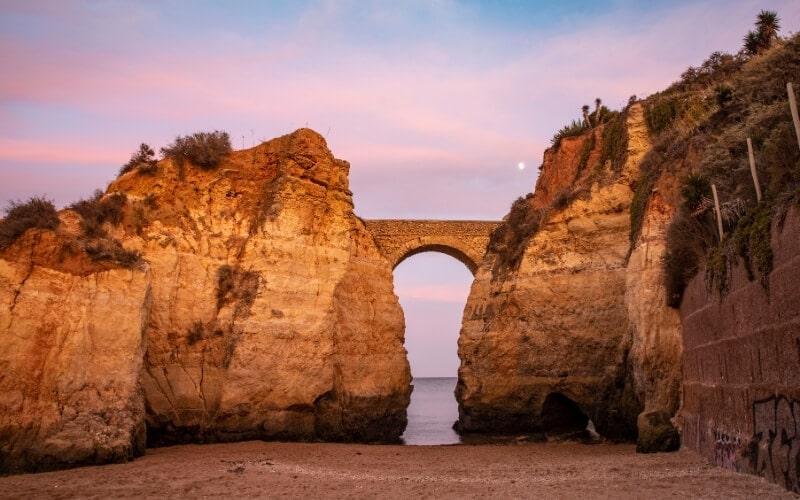
Portugal’s southernmost region of Algarve is known for its golden sandy beaches, secluded swimming coves, rugged cliffs and sculptural sea caves. If you’ve come to Portugal in search of surfing, swimming or sunbathing, a tour of Lagos’s stunning beaches is something not to be missed.
The coastal city of Lagos is the ideal spot for a balance of city and surf. From lounging to exciting water sports, there is no shortage of activities to keep you entertained. Beach-hopping is indisputably the thing to do in this part of Portugal. Highlights include Praia dos Estudantes (‘Students’ Beach’), one of the most striking beaches thanks to the Roman-style bridge – once part of a now-fallen fortress – that stretches out between two rock formations over the ocean. The quiet cove here is ideal for frolicking in peaceful tides.
Meia Praia beach is an enormous stretch of sand just outside Lagos. Spanning a monumental 4 kilometres (2.5 miles), it’s never too difficult to find space to stretch out your towel here.
Visit the anchor cemetery on Tavira Island
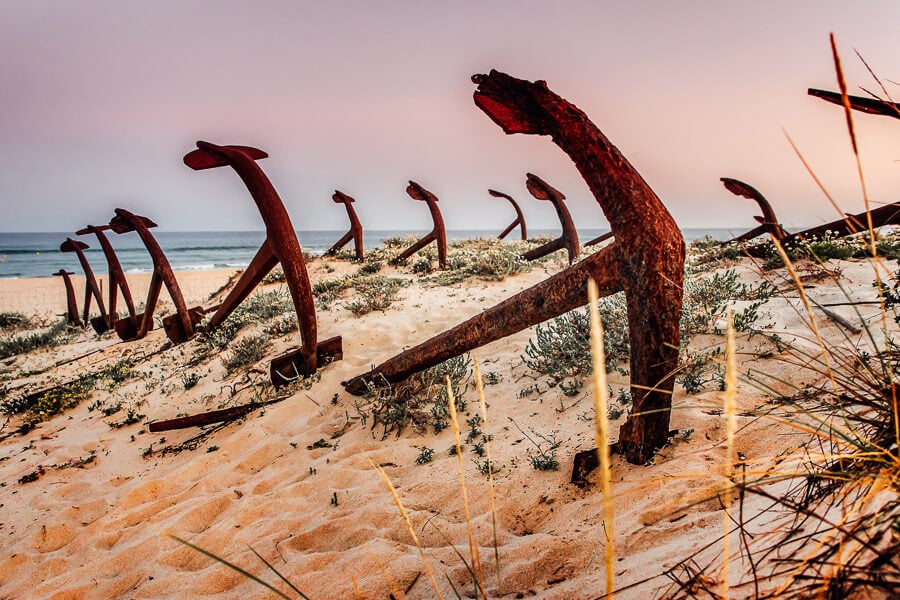
One of the quirkiest attractions in Portugal is the anchor cemetery on Tavira Island. On the sand dunes cascading into Barril beach, there are more than 200 large, rusty anchors. They were once used in tuna fishing when the island was a base for fishermen during the season. When the tuna population declined, the fishermen abandoned their anchors on the beach.
To this day, nobody really knows who collected them all and lined them up – but the truth is, whoever it was did the area a huge favour! Now, instead of being an abandoned location with old tumbledown fishing shacks, it has become one of the most popular tourist attractions in Tavira.
The fishing shacks have been transformed into busy restaurants and cafes, and the old train line that transported the tuna is now being used to ferry tourists on a small scenic train. It costs €1.50 one-way and takes you from the footbridge by Pedras d’El Rei, connecting the mainland with the island, over to the anchor cemetery.
Alternatively, you can walk a 1.3-kilometre-long trail next to the train line. There are also boats and ferries taking visitors from Tavira to the island. Unless you go on a private boat tour, you will be dropped off at Tavira beach. You then have to walk along the beach for 5 kilometres (3 miles) to reach the anchors.
By Linn from Amused by Algarve
Visit the Capela dos Ossos ‘Bone Chapels’ in Evora & Faro
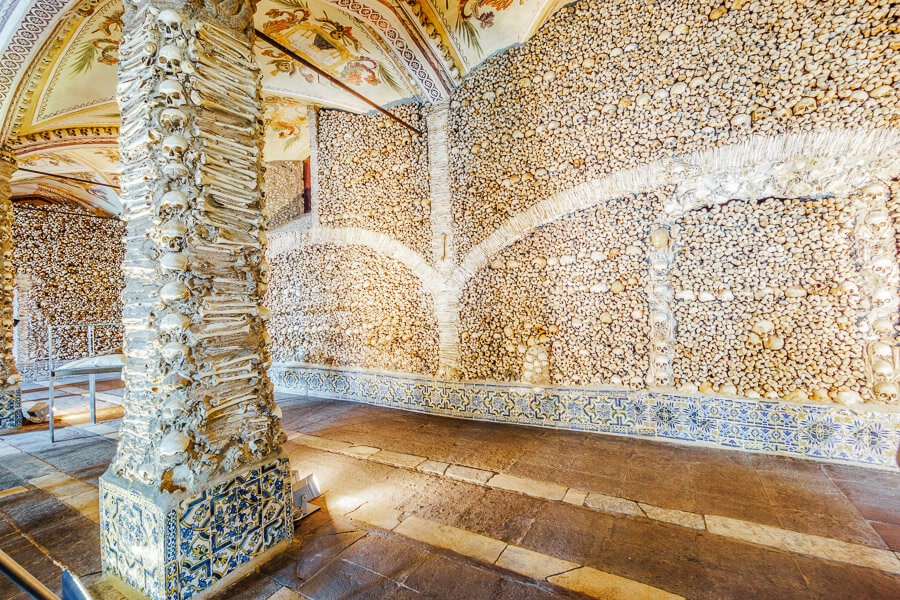
Many visit Portugal for the beaches, the food and the epic palaces – but there is something more off-beat that draws visitors to Portugal: a visit to the famous Capela dos Ossos or ‘Bone Chapels’.
Some will consider these unique religious sanctuaries a dark tourism destination, and while they are not for everyone, they are a very interesting (if not a bit macabre) site. The two most popular bone chapels in Portugal are at Evora and Faro. Both are very different from one another and for many visitors, places they never forget.
The Evora Bone Chapel, the larger of the pair, is located near the Igreja de São Francisco Évora Chapel (St. Francis Church). Crafted from the bones of more than 5,000 individuals, the chapel measures 18 metres long and 11 metres wide. The bones are laid out expertly, with skulls positioned in the interior as rousing decorations.
The second Capela dos Ossos, the Faro Bone Chapel, is located in the town of Faro within an unsuspecting church, the Igreja Do Carmo, in a small square. The tiny bone chapel is located at the rear of the church off a beautiful garden. This bone chapel is a complete contrast to the Evora Chapel in that it’s only 5 metres long and just over 2 metres wide.
By Bec from Wyld Family Travel
Walk part of the Portuguese Camino de Santiago

Walking the Portuguese Camino de Santiago is an amazing cultural experience and a great way to discover the country. The Portuguese Camino is the second most popular Camino route; about 100,000 people accomplish it every year.
Starting in Lisbon and finishing in Santiago de Compostela in Spain, the total distance of the Camino from Lisbon is 630 kilometres (391 miles). It takes 30 days to complete. Many people start walking the Portuguese route from Porto, which reduces the distance to 260 kilometres (162 miles). The way is marked with yellow shells and arrows.
Spring is the best time for walking the Portuguese Camino. The weather is nice, it’s warm and sunny, there are not too many tourists, and fields and hills along the route are covered in wildflowers.
Crossing a country on foot, visiting both well-known attractions and off-the-beaten-path places, is a truly unique way of travelling. Some of the highlights of the Portuguese Camino include Lisbon, Santarem, Fatima, Tomar, Coimbra, and Porto.
The best thing about the Camino is that anybody can do it. There are no rules or limitations – you can complete the entire Camino or walk only a section, carry your own backpack or use a luggage transfer service.
By Alya from Stingy Nomads
Learn to surf in Nazare
Nazare on the Costa da Prata is a magical place, even more so if you’re a surfer searching for the best waves on earth. Pros and novices alike have wet dreams of the legendary Nazare waves. Riding in Nazare’s cold Atlantic water and frothy white surf is about as refreshing and exhilarating as it gets.
According to the Guinness Book of Records, Praia do Norte (North Beach) in Nazare is home to the world’s largest waves ever surfed. The wide beach is just the place for experienced surfers hoping to ride one of Nazare’s legendary monster waves, which often reach up to 30 metres (almost 19 miles) high.
The lighthouse on the cliff above Praia do Norte is the best vantage point to watch these giant waves and the gutsy surfers living their best lives. Inside the lighthouse is a cool surf museum with paraphernalia and quotes from famous surfers who braved the monsters and lived to tell the tale.
Nazare is a great place for beginners, too. There are several surf schools and camps in town to choose from. Instructors will ease you into things and build up your confidence on the town beach with smaller waves. When the time is right, you will join the legends of Praia do Norte.
By De Wet & Jin from Museum of Wander
Go stargazing in Monsaraz

Right in the middle of the famous wine producing region of Alentejo in Portugal is an internationally certified Dark Sky Reserve, the first in the world to be recognised as a UNESCO ‘Starlight Tourism Destination’. The inky skies above Alqueva is a wonderful natural planetarium where there is almost no light pollution, making the whole area wonderful for star-gazing. It’s a must visit on any road trip of Portugal.
On the edges of the hauntingly beautiful Alqueva Dam is the walled town of Monsaraz, home to the Observatorio do Lago Alqueva. Here you can learn about the Portuguese night skies and spend a few hours with their telescopes observing the constellations and planets of the solar system and the craters of the moon.
The quality of the Alqueva sky enables naked eye observation of a large number of celestial bodies. Your tutor for the evening will bring the sky to life. You’ll find out about the history of astronomy and how the first scientists discovered the stars and planets, how they were named, and what is known about each of them.
On the right night, and with the right conditions, the velvety sky above Monsaraz may even show you the Milky Way, a hazy band of light seen in the night sky, formed by stars that cannot be individually distinguished with the naked eye. Make sure to bring your camera – you can take images through the telescope for an amazing reminder of your dark skies experience.
By Izzy & Phil from The Gap Decaders
Explore Portugal’s oldest and largest Natural Park, Serra da Estrela

Located in the central part of Portugal, Serra da Estrela Natural Park is a mountainous area that contains the highest peak in continental Europe, known as the Torre. It has another claim to fame for being the first and the largest Natural Park in Portugal (though it doesn’t have the same status as Peneda-Geres National Park, the nation’s only Parque Nacional).
The Serra da Estrela is best visited by car or on a day trip with private transportation as access from the likes of Lisbon and Porto via public transport is not easy. There are several towns dotted around the foothills where you can stay.
Things to do in the Natural Park include taking the cable car down the valley to enjoy views across the Serra da Estrela mountains and beyond. There are also two towers with domed-shaped roofs that were former radar towers for the Portuguese Air Force. They make for great pictures. There is a retail building at the top of the mountain where you’ll find a restaurant and shops selling locally produced crafts and other products.
There are also walking opportunities, waterfalls to find, and a beautiful carving of the protector Saint of the Shepherds called Senhora da Boa Estrela etched into the rock face of the mountain.
If you are looking for unique things to do in Portugal outside of the main cities, jump in a car and head for the Serra da Estrela Natural Park. It is an area of stunning natural beauty and a place not to be missed.
By Cath from Travel Around Ireland
Day trip option: Excursion to Serra Da Estrela departing from Lisbon, Braga or Porto.
Join a Portuguese food tour in Lisbon

Portugal has a lot going for it: an agreeable climate, historical cities, beautiful beaches, and excellent wines including the finest Port wine in the world. Another undeniable national treasure is delicious Portuguese food.
For food travellers, one of the best introductions to the cuisine of Portugal is a dedicated food tour. Most cities around the country offer this experience, but the best place for a culinary exploration has to be Lisbon, Portugal’s food capital.
A walking food tour is no doubt the best way to experience not just food, but also the culture and history of the city. A visit to some of Lisbon’s more traditional local neighbourhood restaurants, cafes, food markets and small shops will give you an insight into how locals live and what they eat.
Most food tours last for around four hours and are a short but tasty introduction to local food specialties that will leave you wanting more. While there are food tours in Lisbon that focus on popular venues and markets such as the Mercado da Ribeira, it’s nice to opt for a smaller tour to discover off-the-beaten-path eateries only the locals know about.
As for the food you’ll try: bacalhau (salted and dried cod fish and Portugal’s National dish) will most certainly be on the tasting menu. Don’t miss caldo verde, sausage and kale soup, or Pastel de Nata – all must-trys when visiting Portugal.
By Lori from Travlinmad
Recommended Libson food tour: 10 tastings of Lisbon with locals.
Eat cozido on Sao Miguel
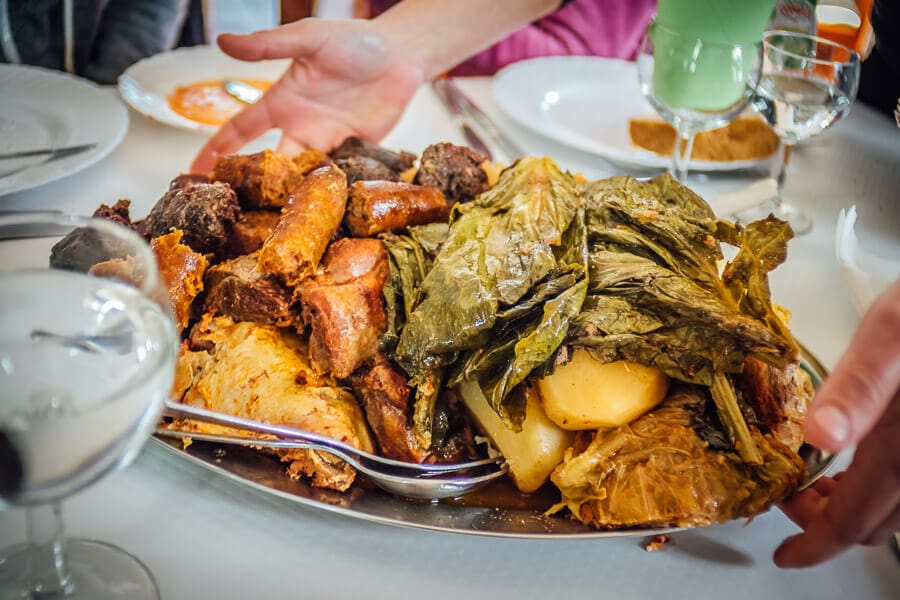
Furnas is located on the southeast side of Sao Miguel island in the Azores archipelago. The town, one of the most popular places to visit on Sao Miguel, sits in the remains of a long-extinct volcano and is the centre of the island’s geothermal activity. Home to hundreds of natural springs and streams, visitors have been coming here for centuries to try the mineral waters and thermal pools. They also come to eat cozido.
Cozido (also known as furnas) is a traditional Portuguese stew made from beef, potatoes and vegetables including carrots and cabbage. Although you can find versions of cozido throughout Portugal, it’s only in Furnas that you will find Cozido nas Caldeiras. Literally translated as ‘cooked in the boiler’, this hearty meal is slow-cooked underground using volcanic heat.
At Furnas Lake there is a cozido cooking spot where local restaurants take their stews to be cooked. Each restaurant has a dedicated underground hole and the area is guarded by two men who are responsible for placing the pots in the ground and later removing them using long iron tongs.
It’s not only restaurants that can use the cooking spot, however – anyone can turn up with their pot and for a few euros have it placed underground. Most cozido are left overnight to cook but you can also take your homemade stew along in the morning and return to collect it 5-7 hours later. Bom apetite!
By Katja from Globe Totting
Go diving in the Algarve
Southern Portugal’s Atlantic coastline is just as breathtaking seen from underwater as from above. Naturally it’s home to some fantastic sites for scuba diving.
Diving conditions are great in the Algarve, with calm seas, good visibility, a rich biodiversity and a variety of interesting underwater attractions. Around the towns of Albufeira, Portimão, Lagos, Faro and Sagres there are a variety of dive sites for all skill levels. The colourful rocky reefs are covered in algae, anemones, soft corals and sponges. If you love marine animals you will not be disappointed diving here.
All dive sites are rich in fish life with sea bass, sea bream, groupers and plenty of other species on the reefs. Keep an eye out or your camera ready for interesting creatures including colourful nudibranchs, octopus, moray eels and even seahorses.
For wreck diving enthusiasts, the Algarve has plenty to offer ranging from old ships from the 1750s to a B-24 Liberator Bomber plane wreck from World War II. Several were purposely sunk to make artificial reefs. Ocean Revival Park in Portimão is a unique diving project where four Portuguese navy vessels were sunk deliberately at different depths to form a marine life sanctuary.
Most dives are done from boats, but entering from the shore at some spots, such as the beautiful Porto de Mos beach in Lagos, is also possible. The Algarve can be divided all year round, but the best conditions are in autumn and spring when the blue waters are clear and the temperatures mild.
By Campbell & Alya from The Algarve Family
What is your favourite thing to do in Portugal? Is there something else I should add to the list?